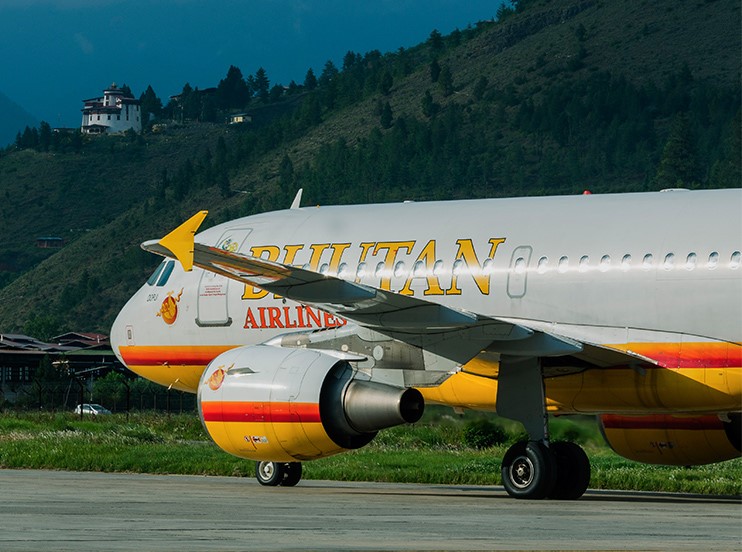How to Get to Bhutan
By Air:
Paro International Airport (PBH): The sole international airport in Bhutan, located in the Paro Valley. It is serviced by two airlines, Druk Air and Bhutan Airlines.
Direct Flights: Available from cities such as Bangkok, Delhi, Kolkata, Dhaka, Kathmandu, and Singapore.
Entry Requirements: A visa is required for all travelers except for citizens of India, Bangladesh, and the Maldives. Visa applications must be processed through a licensed Bhutanese tour operator or one of their international partners.


By Land:
Phuentsholing: The main entry point on the southwestern border with India.
Gelephu and Samdrup Jongkhar: Other entry points from India, suitable for those visiting eastern and southern Bhutan.
-
Best Time to Visit
Spring (March to May):
Ideal for trekking and enjoying the blooming rhododendrons.
Autumn (September to November):
Perfect for clear mountain views and the famous Thimphu Tshechu festival.
Winter (December to February):
Best time to visit for fewer crowds and to experience the Punakha Dromche festival.
Summer (June to August):
Monsoon season; however, the valleys are lush and green.
-
Currency
Ngultrum (BTN): The official currency pegged to the Indian Rupees (INR).
-
Tourism Policy
Sustainable tourism of high value, low volume to avoid negative impacts of mass tourism on fragile environment, and culture and tradition.
The government charges sustainable development fee (SDF) of 100 dollars per person per night as contribution for the promotion of carbon neutral tourism and infrastructure development in tourism industry and social sectors.
-
Visa Requirements
Tourists visiting Bhutan must arrange their trip through an authorized Bhutanese tour operator or one of their international partners.
Visa clearance is processed by the tour operator ahead of the traveler’s arrival.
-
Travel Insurance
While travel insurance is no longer mandatory, it is still highly recommended to provide essential coverage for various potential risks, including:
- Medical Emergencies: Coverage for hospitalization, emergency medical treatments, and medical evacuations.
- Trip Cancellations/Interruptions: Reimbursement for pre-paid, non-refundable travel expenses if your trip is canceled or interrupted due to covered reasons.
- Lost or Delayed Baggage: Compensation for lost, stolen, or delayed baggage.
- Personal Liability: Coverage in case you are held responsible for causing injury or damage to property.
-
Health
Altitude sickness can be a concern, especially in high-altitude areas such as Paro and Thimphu. It’s recommended to acclimatize slowly.
Tap water is generally safe to drink in urban areas, but it’s safer to stick to bottled water, especially in rural areas.
-
Safety
Bhutan is considered very safe for travelers, but it’s always wise to take common-sense precautions.
Be mindful of the altitude, especially when trekking.
-
Cancellation Policy
If due to any unfortunate circumstances you are unable to visit Bhutan, a refund will be made for cancellation as hereunder:
- 100% refund for cancellation of trip before 60 days prior to the date of your arrival,
- 75% refund before 45 days,
- 50% refund before 30 days,
- 25% refund for cancellation made between 14- 7 days,
- No refund for cancellation made less than 7 days prior to trips, and for no shows.
-
What to pack for the trip?
Clothing
- Layers: Moisture-wicking base layers, fleece jacket, lightweight down jacket
- Outerwear: Waterproof jacket and pants
- Tops & Bottoms: Long-sleeve shirts, trekking pants, casual wear
- Accessories: Warm hat, gloves, sun hat, buff
Footwear
- Trekking Boots: Sturdy, waterproof
- Casual Shoes: Comfortable for walking
- Camp Shoes: Lightweight sandals
Gear
- Daypack: For daily excursions
- Hydration: Water bottles or hydration bladder (2-3 liters)
- Headlamp: With extra batteries
-
Time difference
Bhutan has one-time zone for the entire country. It is six hours ahead of GMT. Bhutan is 30 minutes ahead of India, one hour behind Thailand and 15 minutes ahead of Nepal.
-
Accommodation
Bhutan offers a range of accommodation options, from luxury hotels to guesthouses and farm stays.
-
Dress code
Long sleeves and full length trousers, with shoes, are recommended wear when you are visiting dzongs, lhakhangs or religious monuments or institutions.
National dress: (a) Gho worn by the Bhutanese men reaches till the knees and is tied at the waist and (b) Kira worn by women reaches till the ankles.
-
Culture and Customs
Bhutan has a rich cultural heritage, and visitors are expected to respect local customs and traditions.
Dress modestly, particularly when visiting religious sites or government buildings.
Photography may be restricted in certain areas, especially around religious sites.
Widely spoken and used in schools and for official communications.
-
People
Bhutan is ethnically and linguistically diverse. The major groups include the Tshanglalo-speaking Sharchhogpas in the east, Dzongkha-speaking Ngalong in the west and Lhotshampa-speaking Lhotshampa in the south.
There are smaller groups such as Bumthaps in Bumthang, Mangduep in the central region, Layap in the north-west, Brokpa in the north-east and Doyaps in the south-west. -
National Sport
Archery is the national sport of Bhutan is archery, played with much merriment, always wearing the national dress usually with two groups of women singers, cheering and encouraging their own team and jeering at the opponents.
-
Environment
Bhutan is committed to environmental conservation, and visitors are encouraged to respect the country’s pristine natural environment by practicing responsible tourism.